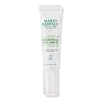What's inside
What's inside
 Key Ingredients
Key Ingredients

 Benefits
Benefits

 Concerns
Concerns

 Ingredients Side-by-side
Ingredients Side-by-side

Water
Skin ConditioningAloe Barbadensis Leaf Juice
Skin ConditioningPropylene Glycol
HumectantGlycolic Acid
BufferingTriethanolamine
BufferingPolysorbate 20
EmulsifyingCitrus Grandis Fruit Extract
AstringentDiazolidinyl Urea
PreservativeBenzophenone-4
UV AbsorberMethylparaben
PreservativeParfum
MaskingPEG-8
HumectantTrimethoxybenzylidene Pentanedione
AntioxidantHydroxyacetophenone
AntioxidantPropylparaben
PreservativeSodium Benzoate
MaskingCitric Acid
BufferingPotassium Sorbate
PreservativeSodium Chloride
MaskingLinalool
PerfumingHexyl Cinnamal
PerfumingBenzyl Alcohol
PerfumingLimonene
PerfumingCitronellol
PerfumingGeraniol
PerfumingCI 42090
Cosmetic ColorantCI 45410
Cosmetic ColorantCI 19140
Cosmetic ColorantWater, Aloe Barbadensis Leaf Juice, Propylene Glycol, Glycolic Acid, Triethanolamine, Polysorbate 20, Citrus Grandis Fruit Extract, Diazolidinyl Urea, Benzophenone-4, Methylparaben, Parfum, PEG-8, Trimethoxybenzylidene Pentanedione, Hydroxyacetophenone, Propylparaben, Sodium Benzoate, Citric Acid, Potassium Sorbate, Sodium Chloride, Linalool, Hexyl Cinnamal, Benzyl Alcohol, Limonene, Citronellol, Geraniol, CI 42090, CI 45410, CI 19140
Water
Skin ConditioningGlycerin
HumectantMethylheptyl Isostearate
Skin ConditioningPolyglyceryl-2 Diisostearate
EmulsifyingSqualane
EmollientPropanediol
SolventTitanium Dioxide
Cosmetic ColorantMica
Cosmetic ColorantCetearyl Alcohol
EmollientNiacinamide
SmoothingCetearyl Olivate
Hydroxyethyl Acrylate/Sodium Acryloyldimethyl Taurate Copolymer
Emulsion StabilisingSilica
AbrasivePhenoxyethanol
PreservativeButylene Glycol
HumectantSorbitan Olivate
EmulsifyingChlorphenesin
AntimicrobialCaprylyl Glycol
EmollientSodium Sulfite
PreservativeCaffeine
Skin ConditioningMaltodextrin
AbsorbentArnica Montana Flower Extract
MaskingCentella Asiatica Extract
CleansingCarbomer
Emulsion StabilisingPolyacrylate-13
Polysorbate 20
EmulsifyingTin Oxide
AbrasivePolyisobutene
Sodium Hyaluronate
HumectantXanthan Gum
EmulsifyingHydroxyethylcellulose
Emulsion StabilisingIsohexadecane
EmollientSorbitan Isostearate
EmulsifyingPolysorbate 60
EmulsifyingPalmitoyl Pentapeptide-4
Skin ConditioningCI 77491
Cosmetic ColorantWater, Glycerin, Methylheptyl Isostearate, Polyglyceryl-2 Diisostearate, Squalane, Propanediol, Titanium Dioxide, Mica, Cetearyl Alcohol, Niacinamide, Cetearyl Olivate, Hydroxyethyl Acrylate/Sodium Acryloyldimethyl Taurate Copolymer, Silica, Phenoxyethanol, Butylene Glycol, Sorbitan Olivate, Chlorphenesin, Caprylyl Glycol, Sodium Sulfite, Caffeine, Maltodextrin, Arnica Montana Flower Extract, Centella Asiatica Extract, Carbomer, Polyacrylate-13, Polysorbate 20, Tin Oxide, Polyisobutene, Sodium Hyaluronate, Xanthan Gum, Hydroxyethylcellulose, Isohexadecane, Sorbitan Isostearate, Polysorbate 60, Palmitoyl Pentapeptide-4, CI 77491
Ingredients Explained
These ingredients are found in both products.
Ingredients higher up in an ingredient list are typically present in a larger amount.
Polysorbate 20 is made by combining ethoxylation of sorbitan, ethylene oxide, and lauric acid. It is a mild cleansing agent, surfactant, and emulsifier.
As a surfactant, it helps collect dirt and oils for washing. Emulsifiers prevent oils and water from separating.
Polysorbate 20 also adds scent to a product. Since it is made using sorbitol, it has a sweet scent. Sorbitol can also be found in fruits such as apples and peaches.
The lauric acid used to create Polysorbate 20 is often derived from coconuts.
Polysorbate 20 may not be fungal acne safe.
Learn more about Polysorbate 20Water. It's the most common cosmetic ingredient of all. You'll usually see it at the top of ingredient lists, meaning that it makes up the largest part of the product.
So why is it so popular? Water most often acts as a solvent - this means that it helps dissolve other ingredients into the formulation.
You'll also recognize water as that liquid we all need to stay alive. If you see this, drink a glass of water. Stay hydrated!
Learn more about Water